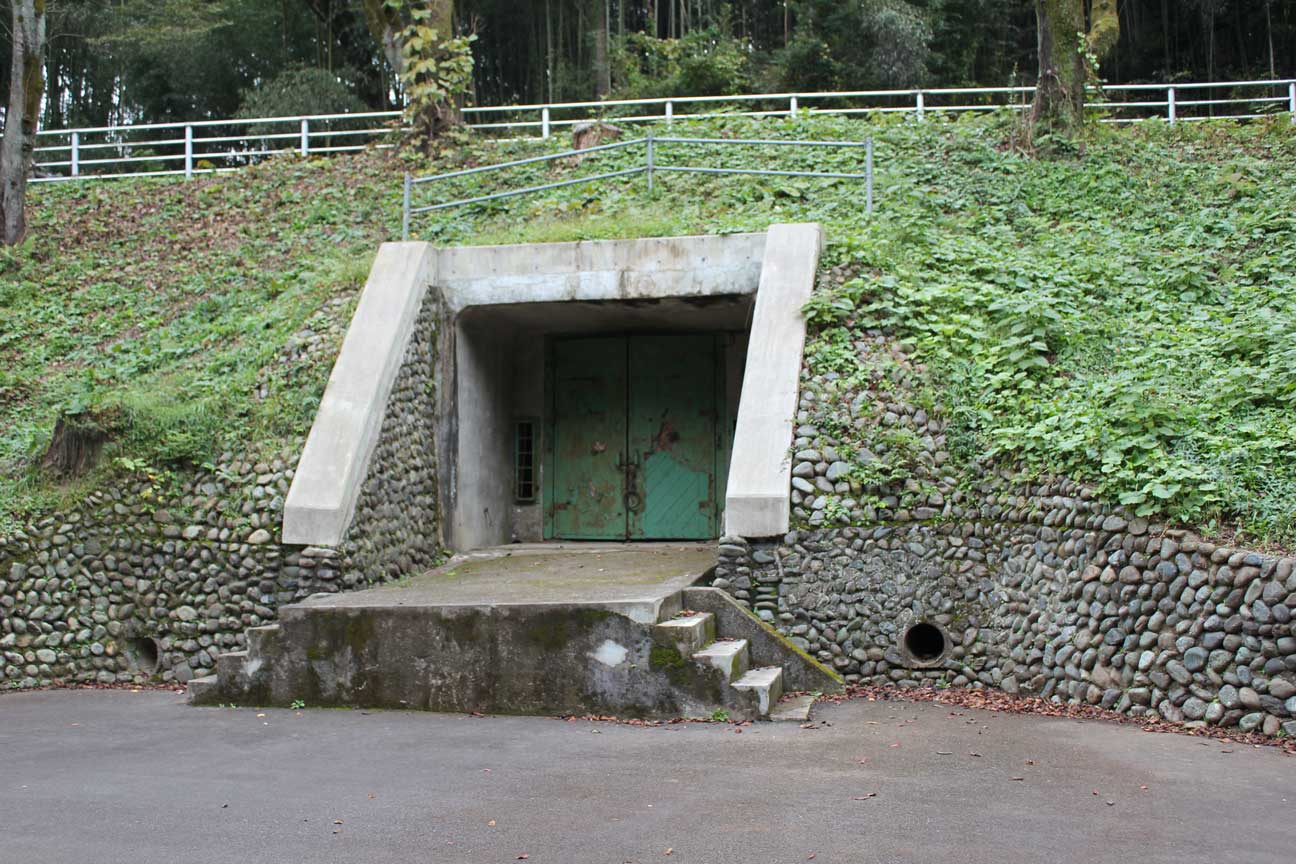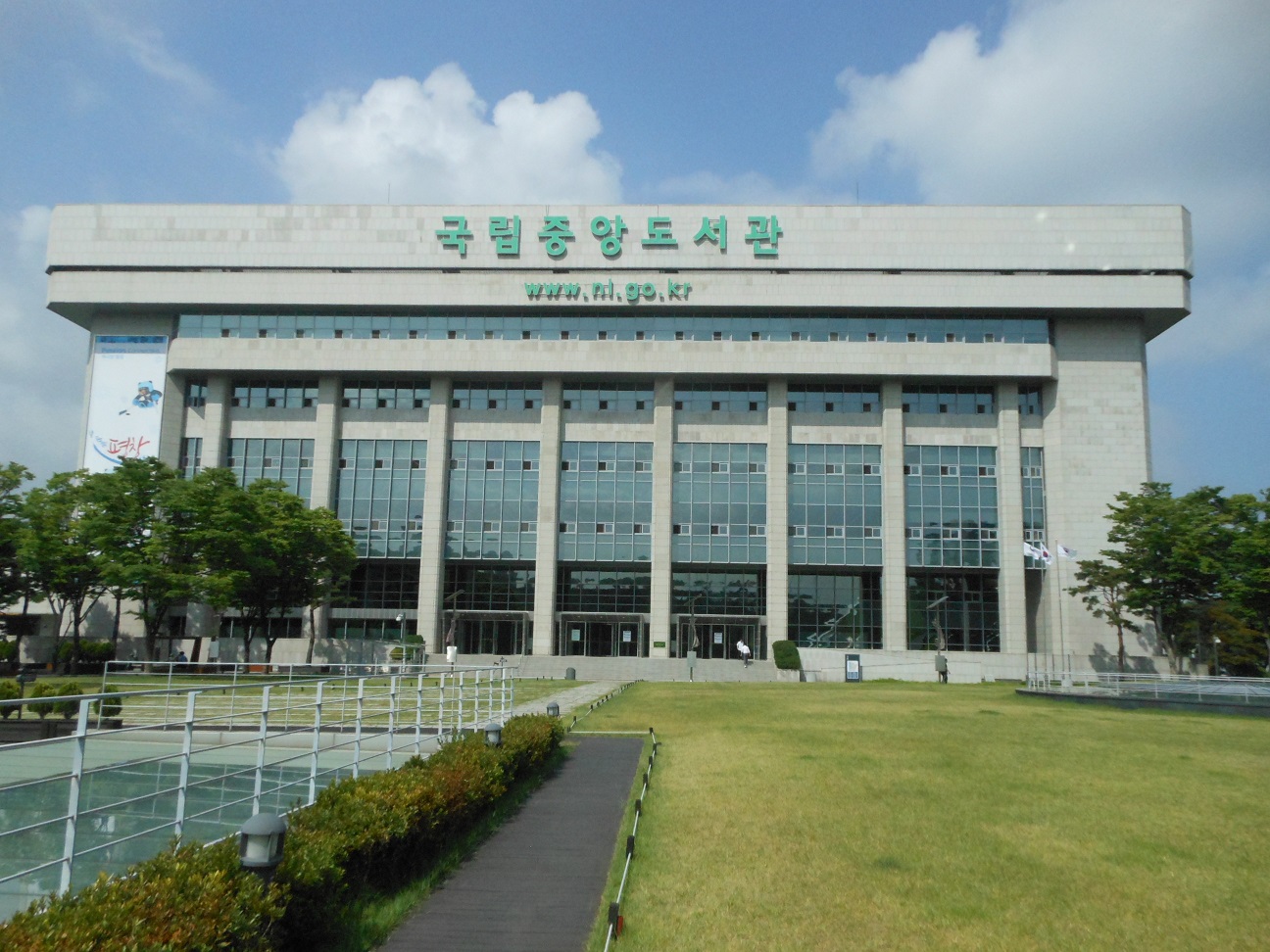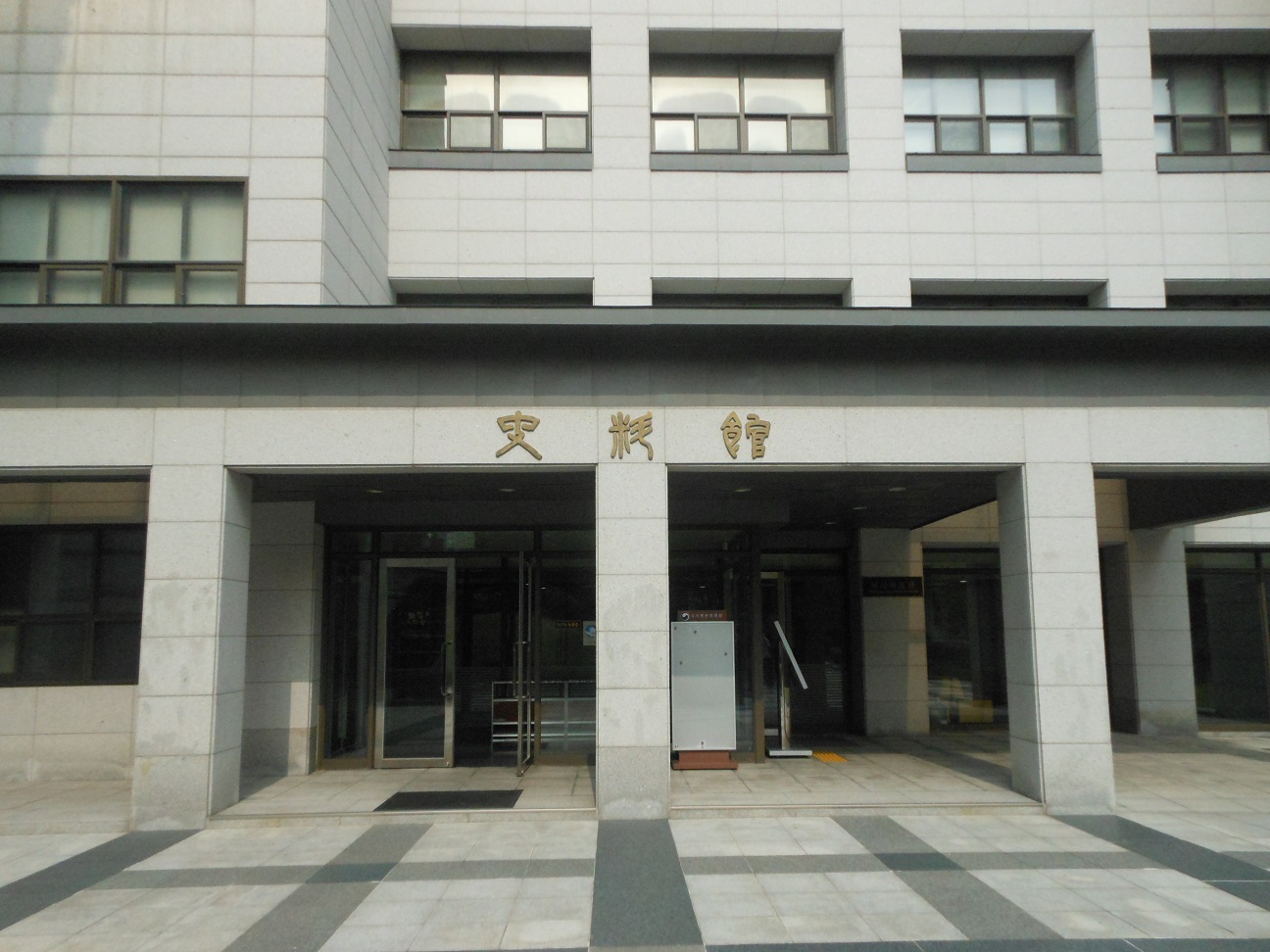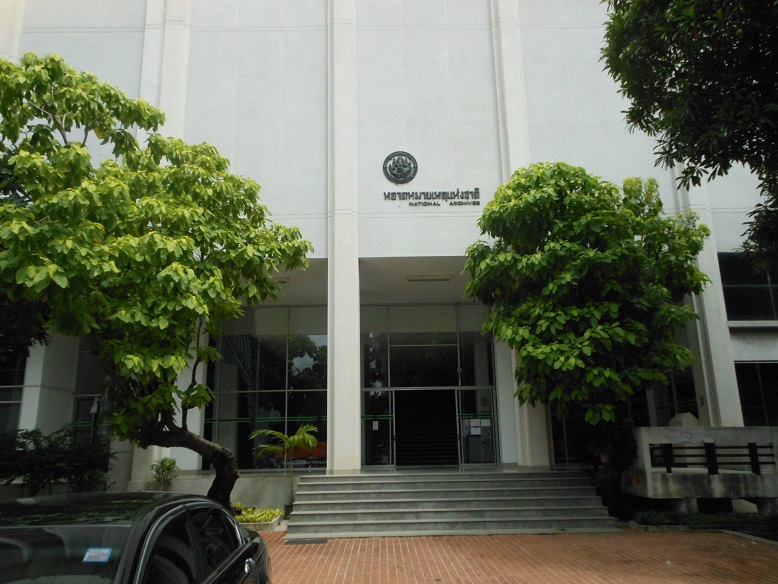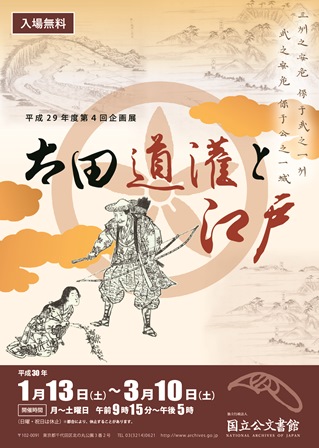

-Documents released on October 12 and December 18, 2017
2. Documents Spotlight "War at Kodomonokuni (“Children’s Land”):From Munitions Depot to Amusement Park" (Hikari Mizusawa, Researcher, JACAR)
3. Outreach Activities
-Publicity Work
4. Information on Related Document Holdings
The Condition of Japan Related Materials in Korea
-National Library of Korea / National Archives of Korea / National Institute of Korean History
The Condition of Japan Related Materials in Thailand
-The National Archives of Thailand
5. Event Informations on the Related Organs
-National Archives of Japan / Diplomatic Archives of the Ministry of Foreign Affairs
These documents are related to the Ministry of Communications, which was established in 1885 and abolished in 1949. The records include documents on departmental division duty regulations (1886-1925), departmental division delegated regulations (1923-1942), departmental delegation regulations (1942-1948), statements explaining organizational revision and budget requisition (1924-1926), government organization revision (1924-1947), and materials following the establishment of the Postal Agency concerning organizational revision and government official’s employment and investiture enactments (1945).
National Archives of Japan > Ministry of Postal and Telecommunications > Records of the Ministry of Communications
Records concerning the Minister's Secretariat, Ministry of Welfare include, illustrative rules (1912-1949), organizations (1938-1945), received documents (1940-1944), proposals (1949-1969), Imperial Diet (1942-1943), the disposition of legislation enacted during World War II (1945-1946), minister succession (1939-1957), GHQ memoranda (1945-1952), materials on air defense (1944), sanitariums for disabled military personnel (1940-1941), and the breakdown of increases and decreases in annual income and expenditure budget items (1938-1945).
National Archives of Japan > Ministry of Health and Welfare > Health and Welfare General Affairs and Accounting Records
Records of the Secretariat, Internal Bureaus, External Bureaus and affiliated institutions of the Prime Minister's Agency (May 3, 1947-May 31, 1949) and the Prime Minister's Office (June 1, 1949), organized and compiled by year and bureau (Prime Minister's Agency Official Documents are (1982 General) 1-60). From 1955 onwards, originals of the Prime Minister's Office ordinances, Prime Minister's Office notifications and Prime Minister's Office directions and others related to the Prime Minister's Office (excluding those concerning personnel) are classified according to the Preserved Official Documents Classification Chart and compiled by relevant preservation period.
National Archives of Japan > Cabinet > Sorifu Kobun: Prime Minister's Office Records
Records of postwar financial history that the Ministry of Finance collected or be given for to compile Records of the Financial History include, documents concerning the Local Public Finance Committee and the Local Public Finance Equalization Grant (Records from the Aoki Tokuzou) , documents concerning the postwar tax reform (Records from the Tanigawa Hiroshi), and more.
National Archives of Japan > Ministry of Finance > Ministry of Finance >Records of the postwar financial history
Records of the Cabinet Meetings, Meetings of the Administrative Vice-Ministers and Other Meetings of Officials, are constructed of cabinet meeting materials; meetings of administrative vice-ministers and others have been placed on file in chronological order. These documents include cabinet meetings, meetings of administrative vice-ministers and other meetings of officials from the Higashikuninomiya cabinet to the third Yoshida cabinet (August, 1945-December, 1952).
National Archives of Japan > Cabinet > Records of the Cabinet Meetings, Meetings of the Administrative Vice-Ministers and Other Meetings of Officials
War at Kodomonokuni (“Children’s Land”):From Munitions Depot to Amusement Park
Kodomonokuni is an amusement park located in the hills between Yokohama City, Kanagawa Prefecture, and Machida City, Tokyo Prefecture, with a lush natural setting that stretches across some 100 hectares (approx. 240 acres). The park’s origins lay in the nuptials of the current Emperor and Empress. The imperial couple proposed that the money they had received as congratulatory gifts from around the country be used to to create a facility for children. Plans were drawn up on that basis, eventually leading to the park’s opening in 1965.
More than 40 million people have passed through Kodomonokuni’s gates since then, and on weekends today the park is thronged by families with children. During the war, however, the picture of this site was a different one for it was home to the Tana Munitions Depot (formally, the Tokyo Army Munitions Depot, Tana Brigade and Dispensary), the army’s largest such installation on the Japanese mainland. In this article, we will draw on JACAR materials to tell the story of the Tana depot from its construction to its demise.
The building of the munitions depot dates to the late 1930s. In 1938, landowners on the Kanagawa side were brought together and pressed into selling their land. We see from the “Application for use of entertainment expenses” (ref: C07091608500), dated May 20, 1940, the chief of the Imperial Guard’s Accounting Department submitted to Army Minister Shunroku Hata that the chief requested 3.5 yen per person (about 100 dollars in 2017) for entertainment expenses for each local official and civilian involved in the land acquisition effort (see Image 1).
Construction was completed at a fever pitch. In January 1941, the army started filling components brought from elsewhere around the country with gunpowder and began the work of manufacturing ammunition of various types including land mines, hand grenades, and anti-tank and anti-aircraft shells to be shipped to the battlefronts. At first, the army brought the ordnance by truck to Nagatsuta Station--the closest Japanese Government Railways (ancestor to the present-day Japan Railway) stop--to be transported by the Yokohama line to the Port of Yokohama. In 1942, construction (begun in spring 1940) on a train line (present-day Tokyu Kodomonokuni Line) running directly from the munitions depot to Nagatsuta Station was completed, making it possible for the army to transport ordnance by train directly from the depot to the port.
Security concerns were raised during construction on the train line when a foreign company in August 1940 attempted to expand its business into the Nagatsuta Station area. The company in question was a German trading house involved in the importation, manufacturing, processing, and sales of machine tools. The Yokohama Line was originally built to transport raw silk from Yamanashi and Gunma prefectures to the Port of Yokohama, and for foreign companies the area around Nagatsuta seemed to have relatively good transportation access.
Aware of the talk about a foreign company building a factory, on August 19, 1940, the Tana Depot sent a request to the commander of the Yokohama Military Police Squad for an investigation into details regarding the factory concerned and the type of operations to be carried out there. The squad carried out the investigation immediately and sent a response dated September 11 that included a list of the company’s executive officers and shareholders, the number of foreign employees, details about the business of the new factory, and a list of army personnel involved with the company. Based on this information, the Army Ordnance Headquarters (the organization within whose bailiwick the depot fell) submitted to the Army Ministry a classified document, “Halting the building of a factory with foreign capital for national security reasons” (ref: C01004814000) (Image 2, Image 3). The document asked for an immediate halt to construction of the factory on the grounds that the presence of a facility where foreigners were free to come and go practically on the doorstep of a military installation was inappropriate from a counter-espionage perspective. Thus, the Headquarters treated the entry of a foreign company to this site to be a serious problem from a security perspective for the munitions depot in that location. However, the Army Ministry came to the conclusion that the details of the matter did not support ordering a halt to the project on counter-espionage grounds.
(Hikari Mizusawa, Researcher, JACAR)
-Overseas
|
August 26-September 4, 2017
|
Held booth exhibition in session at 2017 European Association of Japanese Studies (EAJS) conference in Lisbon./Had discussions about researching archival documents with members of National Library of Portugal and National Archives of Portugal both Lisbon.
|
|
September 13-18, 2017
|
Held booth exhibition and made a report in session at 2017 European Association of Japanese Resource Specialists (EAJRS) conference in Oslo.
↓JACAR’s report as link below https://www.youtube.com/watch?v=8rwaeKRUbhk /Had discussions about researching archival documents with members of National Archives of Norway in Oslo. |
-Domestic
|
November 6, 2017
|
|
|
November 7-9, 2017
|
Exhibited at the 18th Library Fair & Forum at Pacifico Yokohama.
|
The Condition of Japan Related Materials in Korea
The National Library of Korea systematically collects, preserves, and services books at home and abroad. The library owns more than eleven million items, of which some are Asian historical records. There are also materials from the former Governor-General of Korea Library, which was established in 1923 and ran to 1945. The Governor-General of Korea Library sought to collect foreign books required for Korean research while preparing reference materials for colonial governance in Korea with literature about the country. Most books in the Governor-General of Korea Library on the orient were written in Japanese. The Japanese documents divide into two types, classic documents published before the Meiji period and books published once Japanese became an empire. The classic documents contain precious manuscripts and printed books of the Kamakura period and other times. There are also about 140 thousand East Asian books published under the Empire of Japan, which are classified as “new” and have been largely digitized. You can search by title and author names at the National Library of Korea website (*1). On the library website (*2) are releases for the Governor-General of Korea Official Gazette, which was published from 1910 to 1945. You can investigate about Governor-General of Korea official appointments, reassignments, and retirements. There is also information on government agency and public organization establishment, reorganization, and cancelation.
(*1) http://www.nl.go.kr/nl/dataSearch/data_wm.jsp
Websites introduced in this article including the above site are available in English and Korean, but allow keyword searches for Japanese documents. There are many documents that can be viewed in full text on the Internet. If you have an interest, please access the site.
(*2) http://gb.nl.go.kr/
[References] Author: Hyekyong Ahn, Translator: Michiko Nakao, “Kankoku Kokuritsu Tyuuou Tosyokan Syozou no Nihon Kankei Siryou (Japan Related Documents Owned by National Library of Korea)”, Nikkann no Syosigaku to Kotenseki (Bibliography and Classic Books in Japan and Korea), 2015.
The National Archives of Korea seeks to systematically collect, preserve and manage important historical documents. The Government Archives and Records Service was renamed in 2004 as the National Archives of Korea, after a history that started in 1969. The archives owns many of the Governor-General of Korea materials and the holdings are divided into two types. Some are managed by the Administration and Legal Affairs Division of Governor-General of Korea. Most of these materials are documents which local government offices sent to the central government about their own activities. The other variety of documents were saved by central government offices and local government offices, having belonging to the Governor-General of Korea. For more information, please look at Government Archives and Records Documents Catalog (published in 1977-1985) and Japanese Empire Documents Commentary (published from 2004). Parts of materials are released on the archives website (*3), including content such as “Independence Movement Related Decision,” “Japanese Empire Force Occupation Periods Victim List,” “Japanese Empire Periods Architecture Drawing Archives,” “Cadastral Archives,” and “Governor-General of Korea Documentary Materials” (names were translated from Korean)
(*3) http://www.archives.go.kr
[References]
Katsuhiko Murakami, “Kankoku Syozai no Tyousensoutokuhu Monjyo (Governor-General of Korea Documents in Korea)”, 1940 nendai no Higashi Ajia (East Asia in 1940s), 1997.
http://hdl.handle.net/2344/00015801
The National Institute of Korean History plays a key role in research, collection and compilation of historical materials in Korea. The institute has reprinted and released online the Veritable Records of the Joseon Dynasty, which are a national treasure listed from 1997 in UNESCO's Memory of the World registry. Important materials of the National Institute of Korean History include documents put together by the Compilation Board of Joseon History, which began in 1925 as a research institute of Governor-General of Korea. The institute collected an enormous range of materials to compile into History of Korea (published 1932-1938). The materials, 5,000 books and 4,500 photo albums, include images of secret telegrams and official documents between Japanese legations and consulates in Korea and the Japanese Ministry of Foreign Affairs. The National Institute of Korean History also copies Korea related materials from overseas holdings to improve the convenience for researchers in Korea. The institute has compiled materials for research from the United States of America, Russia, Japan, China, Britain, and other countries. Some of the content for researchers has been released online in the institute’s ”Database of Korean History” (*4), including searchable newspapers and magazines from the colonial periods and primary sources of staff lists from the Governor-General of Korea.
[References]
Author: Aiko Ra, Translator: Tatsuki Takizawa,”Kindai Kanniti Kankei Siryou to Sono Katuyou ni tuite: Kokushihensaniinkai Syozou oyobi Kankou Siryou wo Tyuushin ni (Modern Documents between Korea and Japan and Practical Use of these Documents: with a Focus on the Documents Owned or Published by the National Institute of Korean History)” Historical Institute University of Tokyo Research Bulletin No.11, 2001.
https://www.hi.u-tokyo.ac.jp/publication/kiyo/11/kiyo0011-na.pdf
The Condition of Japan Related Materials in Thailand
The National Archives of Thailand were established in 1916 as a unit of National Library of Thailand, Since 1952, they have been under the jurisdiction of the Ministry of Education’s Fine Arts Department.
The National Archives’ holdings primarily are government documents that date back to the reign of King Rama V (1868-1910), contemporaneous to Japan’s Meiji Period. Historical records prior to that time are in the collection of the National Library. The Archives’ records for the years up to the Siamese Revolution of 1932 are sorted by reign (King Rama V through King Rama VII). The files for each grouping in turn--for example, that for “Reign of King Rama V”--contain a catalog listing documents grouped into thematic subcategories such as Politics, Foreign Policy, and Military Affairs. The records for the years after the 1932 Revolution are grouped into categories defined by each government ministry or agency.
Very few of the Archives’ holdings are searchable by database. As a rule, the user searches for records using either the accession list or card catalog. Likewise, only a limited selection of holdings has been digitized. These consist primarily of photographic materials, and are viewable only through the Archives’ in-house network. Incidentally, among these digitized photos are ones taken during the respective postwar visits of Emperor Hirohito and the Thai monarch to one another’s countries.
Japan-related materials can also be found as described above among the files sorted by reign for the years through 1932 and the files sorted by government ministry or agency for the years afterward. For example, records related to Japan in the Ministry of Foreign Affairs file can be found listed under subcategory 25 in the file’s catalog of records broken down by country. Also, the Council of State file contains documents regarding the activities of foreign diplomatic missions in Thailand and these include materials related to Japan’s mission. The diplomatic papers include documents about interactions between Japan’s Foreign Ministry and the country’s diplomatic mission in Thailand; while these documents are written in Japanese, since it is impossible to determine from the catalog whether or not a given document includes Japanese it difficult to search for such materials if one cannot read Thai.
Beyond these, the files for the Supreme Command Headquarters contain a catalog entry titled “Thailand-Japan Relations During the Pacific War,” comprising a single volume comprising in its entirety documents on military relations between Thailand and Japan. This catalog was created with the assistance of former Osaka University of Foreign Studies Professor Yoshikawa Toshiharu with the purpose of creating Thai language entries in the catalog. The collected documents are diverse, including such items as a greetings card from Sugiyama Hajime to Plaek Phibunsongkhram (aka “Phibun”) written on “Office of the Imperial Army Attache Resident in Thailand” letterhead and a written agreement on using Thai railroads for Japanese troop movements. (*5)
In addition, Thailand was one of the nations that extended diplomatic recognition to the “State of Manchūkuo” and the Archive holds numerous documents related to that entity. The Council of State documents include the minutes of discussions on whether or not to recognize Manchūkuo in the wake of the Manchuria Incident, while documents dating to when recognition was extended are sorted as appropriate into the Council of State and Ministry of Foreign Affairs files. The Ministry of Foreign Affairs materials also include numerous documents exchanged with the diplomatic mission for Manchukuo established in Thailand. Many of these items were written under the names of “Envoy Extraordinary and Minister Plenipotentiary in Thailand for the Empire of Manchuria Zheng Yu and “Envoy Extraordinary and Minister Plenipotentiary in Thailand Tsubogami Teiji,” allowing us a glimpse at a part of diplomacy being carried out by a Manchūkuo that in fact had no authority to carry out an independent foreign policy. There are also documents of deep interest related to the treatment of the Manchūkuo diplomatic mission in Thailand after the war’s end.
The documents in the Archives that inolve Manchūkuo include materials written in Chinese, Japanese, and English, along with Thai. From this, it is possible to get the gist of the content of particular items. However, as noted earlier the catalog entries do not include information about the language of each item, and since the catalog itself is written in Thai it is difficult to use for those users who cannot read that lanugage. Still, it is safe to say that these materials are nonetheless important in the sense that they are historical records located overseas connected to Japanese history from the years before to after the Pacifc War.
(*5) Works in which Yoshikawa Toshiharu has used materials from the National Archives of Thailand for his research include Taimen tetsudō: Kimitsu bunsho ga akasu Ajia Taiheiyō sensō [The Burma Railway: The Asia-Pacifc War that classified documents reveal] (Tokyo: Dobunkan, 1994) and Dōmeikoku Tai to chūton Nihongun: “Daitōa sensō” ki no shirarezaru kokusai kankei [Allied nation Thailand and the occupying Japanese Army: Unknown international relations during the “Greater East Asia War” period] (Tokyo: Yuzankaku, 2010).
|
Period
|
Event
|
About
|
Link
|
|
January 13 to March 10, 2018
|
Ōta Dōkan is said to be exemplary of wisdom and courage; he was active as a bushōo in Japan’s Kantō region in the late 15th century, and he was respected for his waka poetry. Dōkan is also famous for having Edo Castle built, which later came to house the Edo Shogunate, and he served the Ōgigayatsu-Uesugi family. He was active in the Kyōtoku War of 1454. This exhibition shows materials of the National Archives on Ōta Dōkan, and introduces his life in relation to pre-modern Tokyo.
|
||
|
January 20 to March 18, 2018
|
"Exhibition from the Holdings of the National Archives of Japan:
The History of Japan and Fukui in the Meiji Era" 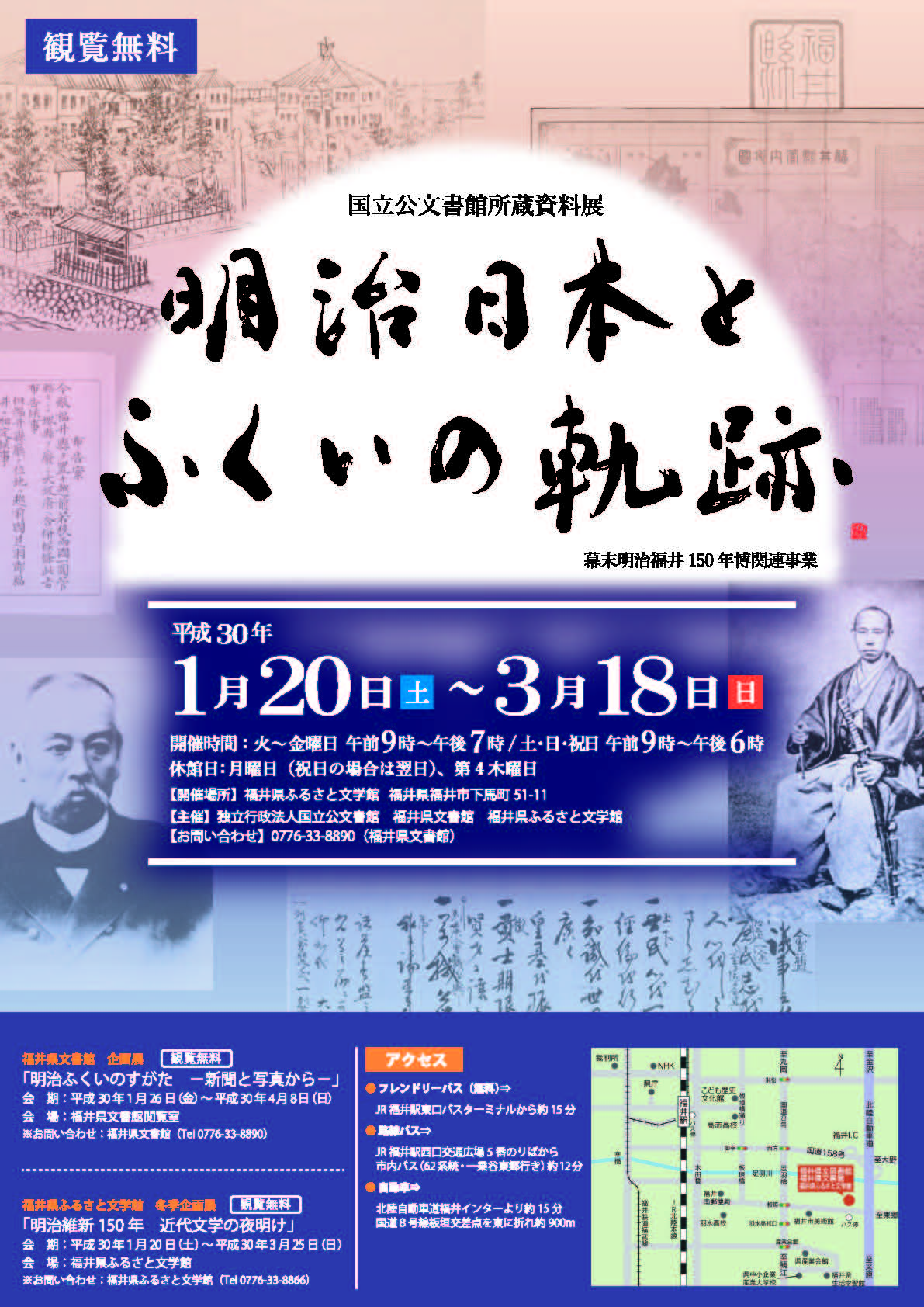 →PDF (1.49MB) |
Since fiscal 2012 the National Archives of Japan has been holding exhibitions at regional archives. This fiscal year an exhibition will be held in cooperation with Fukui Prefectural Archives and Fukui Museum of Literature. The exhibition explores the history of Japan and Fukui in the early Meiji Era; it shows important documents and materials about the people who are connected with Fukui and its establishment. The materials come from the National Archives of Japan, Fukui Prefectural Archives, Fukui Prefectural Library, and other places.
* This exhibition will be held only in Fukui. |
|
|
Period
|
Event
|
About
|
Link
|
|
January 11 to April 17, 2018
|
Exhibition Commemorating the 150th Anniversary of the Meiji Restoration: Japanese Diplomacy in the Meiji Era as Reflected in Sovereign and Personal Letters.
|
The coming year marks the 150th Anniversary of the Meiji Restoration in 1868. This exhibition displays sovereign and personal letters exchanged between the Emperor Meiji and various heads of state to trace the story of Japanese diplomacy during the Meiji Era.
|
|
[Postscript]
Please email us if you would be interested in a member of JACAR presenting at your organization about our institution and its resources. We go to schools, research conferences, and a range of other institutions.
Leaflets about JACAR are available in English, Japanese, Chinese, and Korean, so if you would like copies, please contact us.
An email about the JACAR Newsletter has been sent to everyone who requested a copy as well as those who have exchanged business cards with JACAR staff members. If you do not wish to receive future e-mails, please let us know.
[Reference] TEL : +81-(0)3-5805-8801 E-MAIL : jacar_enquire@archives.go.jp


![[Image 1] Title: Application for use of entertainment expenses (first image)](img/024_content02_01.jpg)
![[Image 2] Title: Regarding the Sanyo Shokai Factory Construction Project (image 3)](img/024_content02_02.jpg)
![[Image 3] Title: Regarding the Sanyo Shokai Factory Construction Project (image 12)](img/024_content02_03.jpg)
![[Image 4] Title: 131. Han-To-San-Go No. 183 Notice of investigative report on circumstances surrounding the munitions handover (1st image)](img/024_content02_04.jpg)
